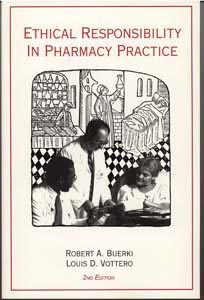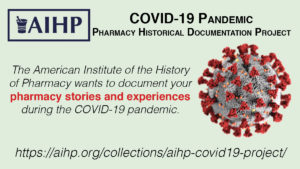Author: Robert A. Buerki and Louis D. Vottero
Publisher: American Institute of the History of Pharmacy
Year Published: 2002
Pages: 272
ISBN: 0-931292-37-9
AIHP#: BKS18
Price: $30.00 ($18.00 for members)
Buy on Amazon
View on Google Books
Read an excerpt from Ethical Responsibility in Pharmacy Practice.
New Material:
Added to the second edition of this comprehensive 272-page textbook:
• Case studies with full commentaries
• Glossary of pertinent terms
• Current issues of ethical concern
Praise for Ethical Responsibility in Pharmacy Practice:
“The extensive use of current pharmacy practice examples throughout Ethical Responsibility in Pharmacy Practice results in a highly accessible presentation of ethical theory which is immediately applicable by both beginning and advanced students…. The layout of Ethical Responsibility could serve as a model syllabus for a course in pharmacy ethics.” —American Journal of Pharmaceutical Education
Introduction to the First Edition:
While the teaching of professional ethics is undoubtedly labor-intensive, it can also be deeply satisfying. By introducing students to ethical concepts, giving them directed practice in applying ethical principles, and allowing them to develop skills in problem-solving and critical thinking, the instructor of professional ethics can heighten student sensitivity, increase professional awareness, and, indirectly, improve health care at the critical pharmacist-patient interface. Ethical Responsibility in Pharmacy Practice is our modest contribution to these goals.
Introduction to the Second Edition:
This new edition of Ethical Responsibility in Pharmacy Practice includes new sections on controversial topics such as terminal sedation, euthanasia, and assisted suicide; ethical issues associated with controlling prices on prescription medication; and the ethical challenges presented by alternative medications. A commentary has been added to each case study, which pharmacy students should find useful as they develop their own set of professional practice values and methods of resolving the ethical conflicts they will face in their professional practice; an extensive glossary of terms has also been added as a courtesy to the reader.
Table of Contents:
1: Chapter 1 Professional Values in Pharmacy Practice
2: Traditional professional values in pharmacy practice
5: Shifting professional values in pharmacy practice
8: Incorporating human values into pharmacy practice
13: The Pharmacist as a Health-Care Provider
13: Traditional boundaries of practice
14: Legal boundaries of practice
19: Expanding boundaries of practice
22: Concluding Remarks
23: Study Questions
24: References
28: Suggested Readings
29: Chapter 2: Foundations of Ethical Decision-Making
30: Ethical Theories and Principles as a Framework for Decision-Making
32: Traditional ethical theories applied to the practice of pharmacy
33: Newer ethical principles applied to the practice of pharmacy
34: Character and virtue in the practice of pharmacy
38: Rights and duties in the practice of pharmacy
40: Professional Codes as a Framework for Decision-Making
41: Difficulties associated with traditional codes
45: A Framework for Ethical Decision-Making in Pharmacy Practice
45: Step one: Problem identification
47: Step two: Develop alternative courses of action
49: Step three: Select one alternative course of action
50: Step four: Consider objections to alternative selected
51: Applying the Ethical Decision-Making Framework
51: Decisions influenced by professional authority
55: Decisions influenced by technical competence
57: Decisions influenced by codes or rules
59: Decisions influenced by legislation
60: Decisions influenced by personal and professional values
62: Decisions influenced by economic forces
63: Concluding Remarks
64: Study Questions
64: Situations for Analysis
65: References
69: Suggested Readings
71: Chapter 3: The Pharmacist-Patient Relationship
72: The nature of the pharmacist-patient relationship
74: The complexity of the pharmacist-patient relationship
75: The Moral Basis of the Pharmacist-Patient Relationship
76: Moral principles affecting the relationship
79: Observing faithfulness in the relationship
81: Incorporating other patient-centered values
83: Conflicts among Role Obligations
83: Maintaining patient faithfulness
86: Restricting professional services
88: Observing truthfulness in placebo therapy
91: Reconciling guilt feelings
93: Maintaining patient confidentiality
95: Concluding Remarks
95: Study Questions
95: Situations for Analysis
96: References
99: Suggested Readings
101: Chapter 4: Ethical Considerations in Professional Communications
102: Communication as an ethical standard
109: Communication as a practice standard
118: Ethical Considerations in Pharmacy Communication
118: Considerations when initiating drug therapy
120: Considerations when monitoring drug therapy
121: Considerations involving irrational prescribing
122: Considerations involving adverse drug reactions
124: Considerations involving self-medication
126: Encounters with Other Health Professionals
126: Establishing professional communications
128: Validating professional decisions
129: Reviewing therapeutic decisions
131: Encounters with Other Pharmacists
131: Dealing with impaired colleagues
132: Maintaining continuity of patient care
134: Reconciling perceived discrepancies
135: Encounters with the General Public
136: Establishing a professional image
137: Championing the cause of public health
139: Extending professional services to the public
140: Concluding Remarks
141: Study Questions
141: Situations for Analysis
142: References
147: Suggested Readings
149: Chapter 5: Ethical Considerations in Drug Distribution
150: Expansion of the drug distribution system
151: Shifting public perspectives of drug distribution
154: Impact upon Professional Pharmacy Practice
155: Freedom of choice of drugs and services
160: The fully informed consumer of drugs and services
165: Access to drugs and professional services
170: Dealing with terminal illness
174: Controlling the prices of prescription medication
178: Wrestling with the challenges of alternative medicines
182: Concluding Remarks
183: Study Questions
183: Situations for Analysis
184: References
187: Suggested Readings
Appendix A
189: Codes of Ethics
189: Hippocratic Oath, 4th century B.C.
190: Philadelphia College of Pharmacy, 1848
193: American Pharmaceutical Association, 1852
195: American Pharmaceutical Association, 1922
199: American Pharmaceutical Association, 1952
202: American Pharmaceutical Association, 1969
204: American Pharmaceutical Association, 1981
206: American Pharmaceutical Association, 1994
208: American Medical Association, 2001
211: American Nurses Association, 2001
212: American Hospital Association, 1992
216: National Association of Boards of Pharmacy, 1992
216: American Pharmaceutical Association Pledge of
218: Professionalism, 1994
219: References
Appendix B
223: Facies Pro Causis
Appendix C
231: Glossary
Table of Cases
52: Case 2.1: Conflicts in Therapy
56: Case 2.2: Conflicts in Drug Selection
58: Case 2.3: Conflicts in Professional Etiquette
59: Case 2.4: Conflicts between Legal and Ethical Practice
61: Case 2.5: Conflicts between Value Systems
62: Case 2.6: Conflicts Arising From Profit Motives
84: Case 3.1: Loyalty to Patient Care
85: Case 3.2: Observing Employment Policies
86: Case 3.3: Curtailing Counseling Services
87: Case 3.4: Managing Conflicting Services
88: Case 3.5: Interpreting Placebo Therapy
89: Case 3.6: Identifying Placebo Therapy
91: Case 3.7: Providing Comprehensive Drug Information
92: Case 3.8: Providing Incomplete Drug Information
93: Case 3.9: Establishing the Boundaries of Confidentiality
94: Case 3.10: Restricting Access to Patient Information
118: Case 4.1: Assuring Informed Consent
120: Case 4.2: Implementing Drug Utilization Review
121: Case 4.3: Establishing Rational Therapy
123: Case 4.4: Monitoring Untoward Reactions
125: Case 4.5: Assuring Rational Autotherapy
126: Case 4.6: Clarifying Physician Orders
128: Case 4.7: Questioning Drug Selection
129: Case 4.8: Monitoring Drug Utilization
130: Case 4.9: Assessing Professional Competence
133: Case 4.10: Preserving Patient Confidence
134: Case 4.11: Defending Drug Product Selection
136: Case 4.12: Advertising Professional Services
137: Case 4.13: Monitoring Questionable Products
139: Case 4.14: Performing Compassionate Acts
156: Case 5.1: Directing Prescription Orders
157: Case 5.2: Limiting Access to Service
158: Case 5.3: Fractionating Pharmacy Services
161: Case 5.4: Advertising Prescription Prices
162: Case 5.5: Choosing among Multisource Drugs
163: Case 5.6: Direct-to-Consumer Advertising
165: Case 5.7: Exercising Professional Discretion
167: Case 5.8: Managing Third-Party Program Conflicts
169: Case 5.9: Participating in Investigational Studies
171: Case 5.10: Managing Cases of Terminal Sedation
173: Case 5.11: Managing Cases of Euthanasia
175: Case 5.12: Professional Responsibility in Controlling Prescription Prices
177: Case 5.13: Serving the Patient within the Boundaries of the Health-Care System
179: Case 5.14: Dealing with Requests for Homeopathic Remedies
180: Case 5.15: Balancing Alternative and Rational Medical Practices



 The American Institute of the History of Pharmacy is documenting and preserving pharmacy stories and experiences during the COVID-19 global pandemic for the benefit of future historians and scholars. We seek to record the effects of this public health emergency on all types of pharmacy experiences. We invite you to share your pharmacy stories, photos, videos, artifacts, and other documentation of the COVID-19 coronavirus pandemic.
The American Institute of the History of Pharmacy is documenting and preserving pharmacy stories and experiences during the COVID-19 global pandemic for the benefit of future historians and scholars. We seek to record the effects of this public health emergency on all types of pharmacy experiences. We invite you to share your pharmacy stories, photos, videos, artifacts, and other documentation of the COVID-19 coronavirus pandemic.